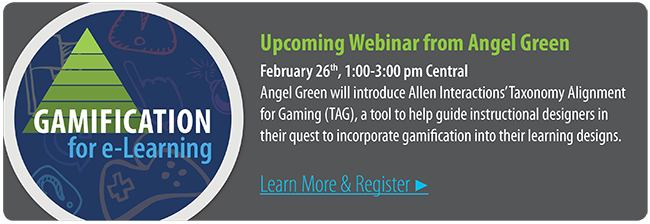Blog
Confusion, Trends & Possibilities with Gamification for e-Learning
By Angel Green, senior instructional strategist | @LearnerAdvocate If, like me, you’ve been in this instructional design world for some time now, you ...


Gamify Your e-Learning Solutions: A Trend 20 Years in the Making
By Angel Green | February 06, 2014 | Custom Learning | 0 Comments

By Angel Green, senior instructional strategist | @LearnerAdvocate
 If, like me, you’ve been in this instructional design world for some time now, you may find yourself a bit hesitant to jump on the latest bandwagon in learning. After all, if you asked me in 2004 what training would look like in 2014, I would’ve likely said, “virtual reality, instructor-led courses taught on training islands in SecondLife, and perfectly meta-tagged learning objects that align to competencies available in the corporate university.”
If, like me, you’ve been in this instructional design world for some time now, you may find yourself a bit hesitant to jump on the latest bandwagon in learning. After all, if you asked me in 2004 what training would look like in 2014, I would’ve likely said, “virtual reality, instructor-led courses taught on training islands in SecondLife, and perfectly meta-tagged learning objects that align to competencies available in the corporate university.”
Enter reality. Unfortunately, it’s not looking much different than it did back then. LMS’s are filled with outdated courses collecting cobwebs, new e-learning reflects the simple cookie-cutter “text and next” format, and does SecondLife even still exist?
But, ever the eternal optimist that I am, I have hope. I hope that if you ask me today what training looks like in 2024 that it won’t look like this. Why? Because I think there is a “trend” worth your consideration to adopt – gamification.
The term gamification is new, but the concept is not. Over twenty years ago, Dr. Allen started Allen Interactions to overcome the very problem of content heavy, boring e-learning. Ten years later, in 2003, he published his Guide to e-Learning, a book that made me an instant Allen fan and introduced me to the concepts of Context, Challenge, Activity and Feedback and the Seven Magic Keys for Motivation. These instructional design models that Dr. Allen wrote about 11 years ago align strikingly well with game design. And yet…here we are today and gaming is made to sound new and fresh.
I ask that you give the trend of gaming consideration in your instructional design for the sake of your learners. Today’s learners have the information they need for virtually any subject with the swipe of a finger. Why should they continue to tolerate listening and waiting for a next button to appear 18 times to find the information they need? Learners can get information anywhere today. Therefore, we can go back to what we were hoping to do all along―help them learn something in training. And, as instructional designers, we know how people learn. We understand, through theory and research that practice, repetition, and failure help people learn. So, let’s start using those very techniques to train our workforce.
How do you incorporate gaming into your learning? How do you create something that is more than just “gaming for the sake of gaming”? How do you move beyond the cool fad of gamification and really produce performance-changing games? By aligning tried and true instructional design theories to your games, that’s how. And when you do, watch out! People will have fun, they’ll learn, and best of all―they’ll perform.
If you want to learn more about techniques to align instructional design theories to gamify your learning, join me for a two-hour training webinar on February 26th. During our time together, I’ll demonstrate the Allen Interactions Taxonomy Alignment for Gaming, a tool to help you decide the appropriate type of game to meet your performance objectives. I hope to “see” you then!

About the Author: Angel Green
Angel Green is a senior instructional strategist for Allen Interactions’ Tampa studio, where she is responsible for providing consultation and instructional design expertise to clients, partnering to build engaging, interactive learning experiences. With nearly 15 years of experience, Angel has worked for organizations such as IBM, MetLife, and PricewaterhouseCoopers, and holds both MS and BS degrees from Florida State University. An accomplished speaker, Angel has held positions as an adjunct instructor of public speaking and is past president of a Toastmasters International chapter. She also frequently blogs on Allen Interactions’ e-Learning Leadership Blog. Angel is the co-author of the Leaving ADDIE For SAM Field Guide. Find Angel on Google+.
Comments
Would you like to leave a comment?
Related Blog Posts

By: Angel Green | Feb, 2014
Category: Custom Learning

Blog
10 Reasons Why You Should Attend the Allen Interactions User Conference
By Angel Green, senior instructional strategist | @LearnerAdvocate If, like me, you’ve been in this instructional design world for some time now, you ...
By: Angel Green | Jul, 2014
Category: Custom Learning, Digital Engineering, Strategic Consulting

Blog
Iterative e-Learning Development: SAM Uncovered
By Angel Green, senior instructional strategist | @LearnerAdvocate If, like me, you’ve been in this instructional design world for some time now, you ...
By: Angel Green | Apr, 2014
Category: Custom Learning, Strategic Consulting


